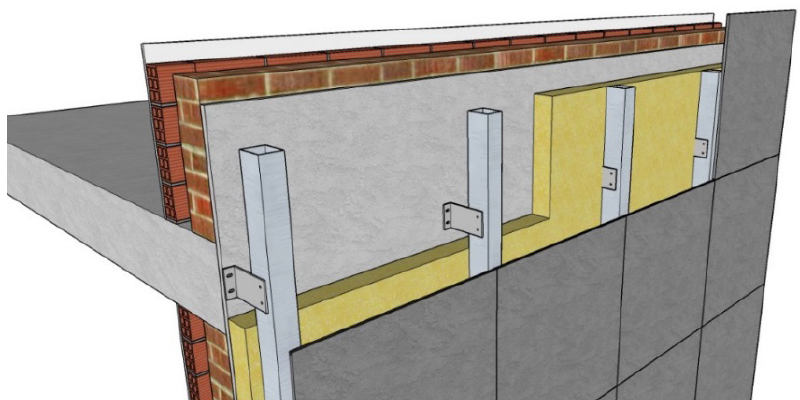Downloads
DOI:
https://doi.org/10.7480/jfde.2018.2.2206Keywords:
Building envelope, Experimental assessment, Thermal bridge, Finite Element, Envelope retrofittingAbstract
A methodological approach to the multi-dimensional heat transfer assessment of building envelopes is performed. The proposed method focuses on thermally weak points in envelope-structure junctions and the assessment of envelope retrofit alternatives. Thermal performance in these spots is seldom assessed in energy audit processes, although it is one of the main heat loss paths in many insulated façade solutions. An envelope-slab junction case is presented, where multi-dimensional heat transfer occurs. This paper proposes a methodology that allows for a hybrid experimental and numerical performance assessment in such circumstances. A numerical model is calibrated against experimental data, which is then modified to reflect various envelope retrofit solutions. Several possible analysis procedures are proposed, based on the capacities of transient thermal models.
G M T Detect languageAfrikaansAlbanianArabicArmenianAzerbaijaniBasqueBelarusianBengaliBosnianBulgarianCatalanCebuanoChichewaChinese (Simplified)Chinese (Traditional)CroatianCzechDanishDutchEnglishEsperantoEstonianFilipinoFinnishFrenchGalicianGeorgianGermanGreekGujaratiHaitian CreoleHausaHebrewHindiHmongHungarianIcelandicIgboIndonesianIrishItalianJapaneseJavaneseKannadaKazakhKhmerKoreanLaoLatinLatvianLithuanianMacedonianMalagasyMalayMalayalamMalteseMaoriMarathiMongolianMyanmar (Burmese)NepaliNorwegianPersianPolishPortuguesePunjabiRomanianRussianSerbianSesothoSinhalaSlovakSlovenianSomaliSpanishSundaneseSwahiliSwedishTajikTamilTeluguThaiTurkishUkrainianUrduUzbekVietnameseWelshYiddishYorubaZulu AfrikaansAlbanianArabicArmenianAzerbaijaniBasqueBelarusianBengaliBosnianBulgarianCatalanCebuanoChichewaChinese (Simplified)Chinese (Traditional)CroatianCzechDanishDutchEnglishEsperantoEstonianFilipinoFinnishFrenchGalicianGeorgianGermanGreekGujaratiHaitian CreoleHausaHebrewHindiHmongHungarianIcelandicIgboIndonesianIrishItalianJapaneseJavaneseKannadaKazakhKhmerKoreanLaoLatinLatvianLithuanianMacedonianMalagasyMalayMalayalamMalteseMaoriMarathiMongolianMyanmar (Burmese)NepaliNorwegianPersianPolishPortuguesePunjabiRomanianRussianSerbianSesothoSinhalaSlovakSlovenianSomaliSpanishSundaneseSwahiliSwedishTajikTamilTeluguThaiTurkishUkrainianUrduUzbekVietnameseWelshYiddishYorubaZulu Text-to-speech function is limited to 200 characters Options : History : Feedback : Donate CloseHow to Cite
Published
Issue
Section
License
Copyright (c) 2018 Roberto Garay Martinez

This work is licensed under a Creative Commons Attribution 4.0 International License.
Authors or their institutions retain copyright to their publications without restrictions.
References
Arregi Goikolea, B., Garay Martinez, R., Riverola Lacasta, A., & Chemisana Villegas, D. (2016). Estudio de transferencia de calor en los puntos de anclaje a forjado de una subestructura de fachada ventilada. III Congreso de Edificios de Consumo de Energía Casi Nulo (EECN); Grupo Tecma Red. ISBN 978-84-608-8686-0.
ASIEPI (2010). WP4, An effective Handling of Thermal Bridges in the EPBD Context - Final Report of the IEE ASIEPI Work on Thermal Bridges
ASTM C1155 - 95(2013) Standard Practice for Determining Thermal Resistance of Building Envelope Components from the In-Situ Data
Atsonios, I.A., Mandilaras, I.D., Kontogeorgos, D.A., & Founti, M.A. (2017). A comparative assessment of the standardized methods for the in–situ measurement of the thermal resistance of building walls. Energy and Buildings 154, 198-206. doi:10.1016/j.enbuild.2017.08.064
BRESAER, BREakthrough Solutions for Adaptable Envelopes in building Refurbishment EU h2020 GA Nº 637186. DOE (2008), 2008 Buildings Energy Data Book. Available from http://web.archive.org/web/20130215004243/http://buildingsdatabook.eren.doe.gov/docs/DataBooks/2008_BEDB_Updated.pdf (2018/05/08)
ECOFYS (2007). U-Values For Better Energy Performance Of Buildings, EURIMA. Available from https://www.eurima.org/publications/13/143/Ecofys-VII-U-values-for-Better-Energy-Performance-of-Buildings.html (2018/05/08)
Elguezabal, P., & Garay, R. (2015). Experiences when employing different alternatives for envelope upgrading. Journal of Façade Design & Engineering 3(1), 81-89. doi:10.3233/FDE-150032
EN ISO 6946:2007. Building components and building elements – Thermal resistance and thermal transmittance – Calculation Method
EN ISO 9869-1:2014 thermal insulation –Building elements- In-situ measurements of thermal resistance and thermal transmittance – Part 1: Heat Flow Meter Method
EN ISO 10211:2007: Thermal bridges in building construction - Heat flows and surface temperatures - Detailed calculations.
EN ISO 13786:2007 Thermal performance of building components. Dynamic thermal characteristics. Calculation methods
EN ISO 13790:2008: Energy performance of buildings. Calculation of energy use for space heating and cooling.
E.U. (2002). 2002/91/EC of the European Parliament and of the Council of 16th December 2002 on the Energy Performance of Buildings
E.U. (2010). 2010/31/EU of the European Parliament and of the Council, of 19 May 2010 on the Energy Performance of Buildings (recast)
EVO, Efficiency Valuation Organization (2012). IPMVP International Performance Measurement and Verification Protocol, Volume 1. Available from http://evo-world.org/ (2018/05/08)
Garay, R., Uriarte, A. & Apraiz, I. (2014). Performance assessment of thermal bridge elements into a full scale experimental study of a building façade, Energy and Buildings 85, 579–591. doi:10.1016/j.enbuild.2014.09.024
Garay, R., Chica, J.A., Apraiz, I., Campos, J.M., Tellado, B., Uriarte, A., & Sanchez, V. (2015). Energy Efficiency Achievements in 5 Years Through Experimental Research in KUBIK, Energy Procedia 78, 865-870. doi:10.1016/j.egypro.2015.11.009
Garay Martinez, R., Uriarte Arrien, A., & Apraiz Egaña, I. (2015). Calibration Procedures for Multidimensional Heat Transfer Models Based on On-site Experimental Data. Energy Procedia 78, 3222-3227. doi:10.1016/j.egypro.2015.11.784
Garay Martinez, R., Riverola, A., & Chemisana, D. (2017).Disaggregation process for dynamic multidimensional heat flux in building simulation. Energy and Buildings 148, 298-310. doi:10.1016/j.enbuild.2017.05.029
Gacía Gil, A. (2008). Modelado de Puentes Térmicos en la Simulación Térmica de Edificios (Master dissertation). ETSII Málaga. Available from https://es.scribd.com/doc/26313726/Modelado-de-Puentes-Termicos-en-la-Simulacion-Termica-de-Edificios (2018/05/08)
Gutschker, O. (2008). Parameter identification with the software package LORD, Building and Environment 43(2), 163–169. doi:10.1016/j.buildenv.2006.10.010
IETCC, CEPCO & AICIA (2010), Catálogo De Elementos Constructivos Del CTE. Available from https://www.codigotecnico.org/images/stories/pdf/aplicaciones/nCatalog_infoEConstr/CAT-EC-v06.3_marzo_10.pdf (2018/05/08)
Kuusk, K., Kurnitski, J., & Kalamees, T. (2017). Calculation and compliance procedures of thermal bridges in energy calculations in various European countries, Energy Procedia 132, 27-32. doi:10.1016/j.egypro.2017.09.626
LBNL (2018). THERM, Two-Dimensional Building Heat-Transfer Modeling. Available from https://windows.lbl.gov/software/therm (2018/05/08)
Martín, K., Flores, I., Escudero, C., Apaolaza, A., & Sala, J. M. (2010). Methodology for the calculation of response factors through experimental tests and validation with simulation. Energy and Buildings, 42(4), 461–467. doi:10.1016/j.enbuild.2009.10.015
Ministerio de Fomento (2013). Código Técnico de la Edificación (CTE). Documento Básico de Ahorro de Energía (DB-HE).
Naveros, I., Bacher, P., Ruiz, D.P., Jiménez, M.J., & Madsen, H. (2014). Setting up and validating a complex model for a simple homogeneous wall. Energy and Buildings 70, 303–317. doi:10.1016/j.enbuild.2013.11.076
O’Grady, M., Lechowska, A., & Harte, A. (2017). Infrared thermography technique as an in-situ method of assessing heat loss through thermal bridging, Energy and Buildings, 135, 20-32. doi:10.1016/j.enbuild.2016.11.039
Pérez-Lombard, L., Ortiz, J., & Pout, C. (2008), A review on buildings energy consumption information, Energy and Buildings 40(3), 394-398. doi:10.1016/j.enbuild.2007.03.007
PHYSIBEL (2009). VOLTRA. Computer program to calculate 3D & 2D transient heat transfer in objects described in a rectangular grid using the energy balance technique, version 6.3w.
Strachan, P.A., & Vandaele, L. (2008). Case studies of outdoor testing and analysis of building components. Building and Environment 43(2), 129-142. doi:10.1016/j.buildenv.2006.10.043
TECNALIA (2013). Estudio de investigación sobre eficiencia energética y viabilidad de la aplicación de fachadas ventiladas en soluciones de rehabilitación, Anexo 4: Caracterización dinámica de los elementos de frente de forjado. Available from http://www.euskadi.eus/contenidos/noticia/20130426_kubik/es_kubik/adjuntos/kubik3.pdf (2018/05/08)
ULMA Architectural (2018). Vanguard Range. Available from http://www.ulmaarchitectural.com/en/ (2018/03/28)
UNEP (2016). Sustainable Building and Climate Initiative. Available from http://www.unep.org/sbci (2016/04/28)
